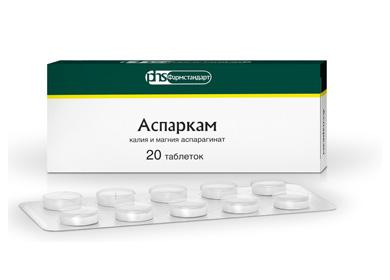The content of the article
According to the data cited in the medical literature, more than half of Russia's population suffers from a lack of certain macro- and micronutrients. Moreover, quite often it is a deficiency of magnesium and potassium. This is especially true for patients at risk: adolescents, pregnant women, patients with chronic pathologies. In this case, the reason for the decrease in the level of cations is the increased need of the body for their intake.
In addition, the causes of low potassium and magnesium levels in the blood may be taking certain medications:
- some groups of diuretics;
- cardiac glycosides;
- gentamicin and its analogues;
- amphotericin.
Thus, there are a number of conditions, pathological or physiological, when correction of a deficiency of potassium and magnesium in the body is necessary. For this purpose, the pharmaceutical preparation Asparkam was developed, which makes it possible to fill the deficit of these cations.
What is a
"Asparkam" is a complex of potassium and magnesium salts based on aspartic acid. According to studies, it was suggested that asparaginate ion significantly improves the transport of trace elements into the intracellular space. In addition, asparaginate is able to independently engage in intracellular metabolic processes.
As you know, potassium plays a crucial role in the smooth muscle work, is involved in nerve impulses. Its deficiency can provoke interruptions in the work of the heart, in particular, with its deficiency, arrhythmias and changes in the electrocardiogram can be diagnosed.
When appointed
The most common indications for the use of Asparkam are:
- lack of potassium and magnesium in the body;
- chronic cardiovascular failure;
- cardiac arrhythmias, tachycardia;
- coronary heart disease;
- emergency conditions (to maintain heart activity);
- overdose of cardiac glycosides.
This drug is prescribed for the prevention of electrolyte disturbances, for example, for patients taking diuretics for a long time. Diuretics are often used for edema in the presence of heart disease or cirrhosis, hypertension syndrome after head injury (concussion, brain contusion), and epilepsy and ischemic lesions of the central nervous system.
It may also be necessary to prescribe Asparkam during treatment with hormonal drugs. This situation occurs with gout, rheumatoid diseases, complications with menopausein oncology.
What are the forms of release
Asparkam is available in the form of tablets and a solution for intravenous administration. The tablets are intended for oral administration, in their composition the same amount of magnesium and potassium asparaginate (0, 175 g each). Tablets can be packaged in blisters or in small plastic packaging.
The Asparkam solution is placed in small ampoules of ten or twenty milliliters. In ampoules of 20 ml contains magnesium and potassium asparaginate in an amount of 0.8 and 0.9 g, respectively.
"Asparkam": instructions for use
Usually, the duration of treatment and dose is determined by the doctor.
- Asparkam tablets. Assign after eating. This is due to the fact that acidic gastric juice negatively affects the activity of the drug. For adult patients, the “Asparkam” regimen is as follows: one or two tablets up to three times a day. According to the testimony, the amount of medication can be increased to nine tablets per day, divided into three doses.
- Solution. Enter only intravenously. The usual dosage of "Asparkam" for adults is 10-20 ml of solution. Before administration, it is dissolved in physiological saline (200, 500 ml). After that, drip administration is carried out at a rate of not more than 25 drops in one minute.
Also, jet medication is allowed. For this, 10 ml of Asparkam is diluted in 20 ml of physiological saline. Then a slow intravenous administration is carried out. However, the rate of administration of the drug should not exceed 5 ml in one minute.
Side effects
According to doctors, if the dosage is observed during the administration or administration of a drug, then, as a rule, side effects are extremely rare. In some cases, patients may experience the following side effects of Asparkam:
- nausea, vomiting, dry mouth, abdominal pain;
- thrombotic changes in the veins;
- slow heart rate;
- lowering blood pressure;
- changes in the electrocardiogram;
- vestibular disorders;
- sensitivity changes, cramps;
- respiratory failure;
- sensation of hot flush in the body.
If these doses are exceeded, signs of an overdose may develop. Symptoms of hyperkalemia are:
- decreased muscle tone;
- tingling in arms and legs, numbness;
- heart rhythm disturbance, bradycardia, asystole;
- slowing of cardiac conduction.
Signs of hypermagnesemia are the following symptoms:
- facial redness;
- lowering blood pressure;
- attenuation of reflexes;
- arrhythmias;
- convulsive syndrome.
The treatment in this case consists in the introduction of calcium chloride, as well as symptomatic therapy. In severe cases, hemodialysis is performed.

Contraindications
The main contraindications for the use of Asparkam are as follows:
- intolerance to its components;
- low numbers of blood pressure;
- high levels of potassium and magnesium in the blood;
- high degree of atrioventricular block;
- peptic ulcer of the stomach and duodenum, bowel obstruction.
Where to buy and what analogues exist
"Asparkam" refers to an over-the-counter drug group.To purchase it, there is no need to present a doctor's prescription. The cost of Asparkam is quite affordable. One package containing 60 tablets will cost only 30-35 rubles. Packaging with ampoules costs 70-75 rubles. (November 2017 data)
Reviews about "Asparkam" testify to it as an inexpensive and quite effective tool that can make up for the deficiency of potassium and magnesium in the body. However, when taking it, you should adhere to the dosages indicated by the doctor. When using large doses of the drug, side effects can occur, in rare cases, the occurrence of hyperkalemia or hypermagnesemia.

